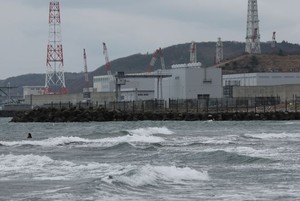By SATORU KAMIBAYASHI/ Staff Writer
March 11, 2022 at 12:00 JST
NAKIJIN, Okinawa Prefecture--Skeletal human remains bearing characteristics associated with medieval people in mainland Japan provide the strongest evidence yet of a migration to the nation’s southernmost island during a key transitional phase in Okinawa’s history, according to researchers.
The shape of skulls unearthed there suggest that a seafaring wave of people crossed over to Okinawa during the 11th to 15th centuries, which marked the waning of the hunter-gatherer Kaizuka period and the start of the Gusuku period when castle-like "gusuku" fortresses began to appear for the first time.
This, say some experts, provides clues to better grasping the transition to the Gusuku period, which until now had remained murky.
Researchers last year confirmed that 26 skeletons excavated at a cave in Nakijin in the northern part of the main Okinawa island dated from the Gusuku period.
The males had robust frames, unlike those from other periods in Okinawa’s development that were previously excavated. Several female specimens exhibited prognathism, or protruding jaws.
Naomi Doi, formerly an associate professor of anthropology at the University of the Ryukyus in Nishihara, Okinawa Prefecture, who analyzed the remains, said skulls excavated in mainland Japan from the Kamakura to Muromachi periods (1185-1573) bear common characteristics, such as elongated heads from front to back, flat faces and prognathism.
But the skulls of Okinawan people lack these features, she said.
Doi previously took part in an excavation of the Urasoe Yodore site in Urasoe, which is thought to be a late 13th-century mausoleum for the royal family who ruled the central region of the main Okinawa island. She managed to reconstruct a single skull from 118 remains.
It was strikingly similar to those of mainlanders from medieval times.
Skeletal remains with similar characteristics found in medieval mainlanders have also been found at archaeological sites on the main Okinawa island. They include the Katsuren Castle ruins in Uruma and Shuri Castle in Naha, both of which have World Heritage status, as well as a cluster of ancient tombs at Nakandakariyama, also in Naha, and other sites on Miyakojima, Ishigakijima and outlying smaller islands.
“Human remains from the Gusuku period have been unearthed from only a small portion of archaeological sites, but some of them bear characteristics similar to those of mainlanders from medieval times in most of those sites,” Doi said.
Because it is rare for so many skeletal remains to be discovered collectively, as in the Nakijin case, experts are keeping a close watch on the results of detailed analysis.
The history of Okinawa differs markedly from that of mainland Japan, with the Old Stone Age followed by the Kaizuka period (between the prehistoric Jomon Period and the late Heian Period running from 794 to 1185 in mainland Japan), the Gusuku period and the Ryukyu Kingdom period (1429-1879).
However, it remains unclear how hunter-gatherers of the Kaizuka period began farming and constructing stone-built gusuku fortresses.
If medieval mainlanders actively relocated to Okinawa around that time, as the evidence suggests, archaeological sites in the Amami islands of Kagoshima Prefecture located midway between the mainland and Okinawa may hold the key to solving the mystery.

The ruins of a large medieval settlement were found recently on Kikaijima island, one of the Amami islands.
Researchers excavated the remains of nearly 600 pillar-supported buildings, burial human remains and remnants of cereal grains, as well as cattle and horse bones, from the cluster of the Gusuku ruins built between the late eighth century and the 15th century, when the settlement was mostly occupied.
Initially, the site was presumed to have been a relay point for the Dazaifu regional government office to purchase green turban shellfish and other produce from southern islands.
However, Kamuiyaki ware, Chinese white porcelain bowls and fragments of stone pots made in present-day Nagasaki Prefecture that were excavated in abundance were also widely used across the entire Ryukyu islands between the late 11th century and the early 12th century.
The remains of about 100 kilns where Kamuiyaki ware was produced were also found in nearby Tokunoshima island.
Further indications that the settlement was the hub of a major trading zone in the early Gusuku period came with the discovery of the ruins of a 12-century furnace used to produce iron from ironsand in the cluster of the Tekuzuku ruins on Kikaijima island.
Yoshifumi Ikeda, professor emeritus of archaeology at the University of the Ryukyus who has made a detailed study of the Gusuku ruins, speculated that mainlanders relocated to the Okinawa islands in early medieval times using Kikaijima as a foothold.
He cites the Kushikanekubaru ruins in Chatan and other sites on the west coast of the main Okinawa island, from which Kamuiyaki ware, Chinese white porcelain bowls and Nagasaki-made stone pots were also excavated, as their destinations.
“We have yet to identify what caused them to relocate, but it appears that agricultural technology and horses and other livestock were brought into Okinawa, which helped to foster development,” Ikeda said. “I think they also gradually interbed with the local population.”




















A peek through the music industry’s curtain at the producers who harnessed social media to help their idols go global.
A series based on diplomatic documents declassified by Japan’s Foreign Ministry
Here is a collection of first-hand accounts by “hibakusha” atomic bomb survivors.
Cooking experts, chefs and others involved in the field of food introduce their special recipes intertwined with their paths in life.
A series about Japanese-Americans and their memories of World War II